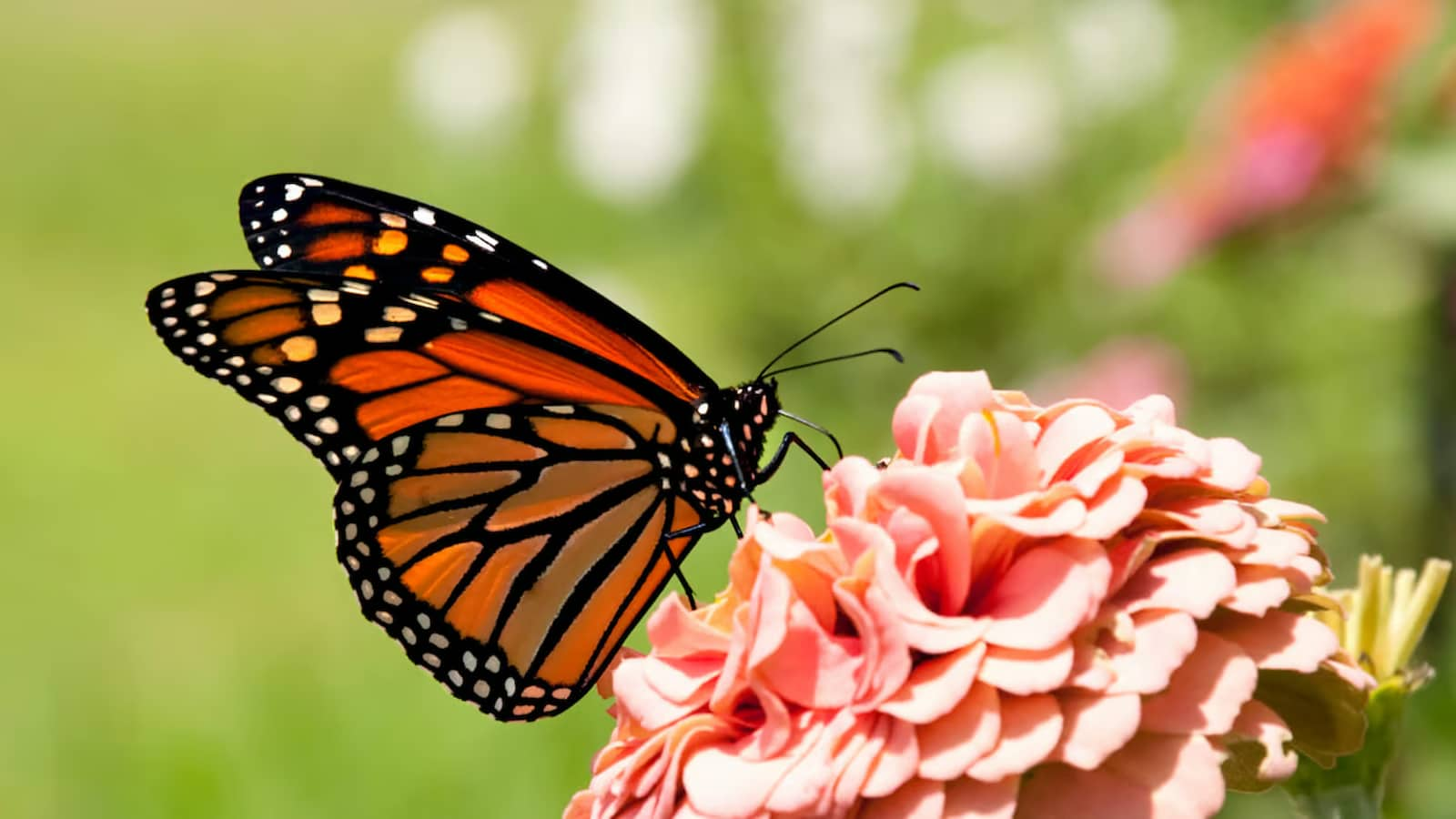Western Monarch Day 2024 (US): Western Monarch Day, observed on February 5, is transporting us to another, more attractive realm through the flapping of vibrantly colored wings. As part of their seasonal migration, the Monarch butterfly covers nearly 3000 miles before returning to California from the western United States. This day was designated to commemorate this event. During butterfly migration season, which is a major tourist attraction, innumerable individuals visit parks and other locations where these avian creatures congregate.
Although the creature’s range is not restricted to a single location, the focus of this day is on their arrival back along the California coast. They must return, as the population of monarch butterflies is plummeting at an alarming rate.
The History of Western Monarch Day
Admirably traversing landscapes in pursuit of pollination, the Western monarch butterfly is a visually captivating specimen, exhibiting opulent colors including red, orange, yellow, and gold. Annually migrating from regions across Northern America, they possess an innate ability to discern the optimal time for departure.
This species, which originated in the American Tropics, disseminated progressively as its principal food source, milkweed, expanded. As the monarchs relocated, their migration patterns evolved into the remarkably complex forms in which they exist today. Each winter, monarch butterflies from the western regions of the United States and Canada migrate to California, where their chances of survival are higher. There, they find prospective monarchs who return the following year.
Scientists were not previously cognizant of this pattern, despite their investigation of monarchs dating back to the 1850s. It was not until 1930 that it was determined that these awe-inspiring creatures migrated north in the spring and south for the winter. Subsequently, Frederick Urquhart, a zoologist from Canada, commanded a group of over 3000 butterfly devotees hailing from North America. Their mission was to tag every monarch butterfly on the continent. Urquhart, utilizing the information of all individuals regarding the age and location of monarchs, observed that they appeared to migrate southward, from Texas to northern Mexico.
The whereabouts of the monarchs during the winter remained a mystery until 1973. A businessman named Kenneth Brugger then recounted to Urquhart how he had witnessed a “shower” of monarchs descend from the western highlands in Mexico City amidst a hailstorm. Following Urquhart’s recruitment to the cause, Brugger and his spouse set out on a two-year journey to find the elusive monarch butterflies. Their odyssey was finally fruitful when they fortuitously encountered the butterflies’ wintering ground, a patch of land situated on the Trans-Mexican Volcanic Belt.
At last, the migratory route of the elusive monarch butterfly became evident, attracting a greater number of observers to witness their exquisiteness in their natural habitat. California proclaimed February 5, 2004, California Western Monarch Day in recognition of the monarchs’ massive migration and their enduring presence from October to March, both of which constituted enormous attractions. Public awareness and tourism expansion were their primary objectives regarding this butterfly.
Regrettably, the Western monarch butterfly is in a gradual decline that seems to be approaching extinction. Deforestation and land degradation, excessive pesticide use, climate change, and other factors that may alter migratory patterns (many of which remain unexplored) have all contributed to the decline in the population of these species.
It is critical to comprehend the true significance of a decline in the Western monarch butterfly population, given the challenges posed by migration and their pollination behaviors. The monarch population has decreased by an astounding 90%. Numerous conservation organizations are conducting research and making efforts to avert the extinction of the species.
Scout Sunday 2024 (US): FAQs, Activities, Dates, History, and Facts About Scout Day
Willie Mays Day 2024 (US): History, FAQs, Dates, Activities, and Facts About Willie Mays
Quacker Day 2024 (US): FAQs, Dates, Activities, History, and Facts About Quacker Factory
FAQs on Western Monarch Day
In the West, how many monarchs have reigned?
As a result of conservation efforts, the estimated monarch population for 2018 and 2019 is reduced from nearly 1.2 million in 1997 to 30,000.
The monarch butterfly is significant on the Day of the Dead.
On the Day of the Dead, monarch butterflies symbolize the spirits of deceased loved ones who pay a visit. The fact that the date of this celebration coincides with the butterflies’ winter migration to Mexico lends support to this custom.
What is the distinction between monarchs of the East and those of the West?
Eastern monarchs migrate from the border between the United States and Canada to central Mexico, whereas Western monarchs migrate from the border between the United States and Canada to the Pacific Coast.
What distinguishes the monarch butterfly so uniquely?
The monarch, one of the most recognizable butterflies worldwide, has wings that are orange with black linings and white spots. During the winter, they migrate over great distances from the United States and Canada to California and Mexico, an activity that has earned them a reputation.
Activities for the Western Monarch Day holiday
Observe the butterfly
During the summer, thousands of butterflies congregate in California; you can observe them in person or virtually. You could also organize excursions to nearby butterfly sanctuaries to observe monarch butterflies.
Engage in conservation endeavors.
One may contribute to the conservationists’ cause financially, assist in the dissemination of information, or gather data to aid scientists in their investigation of this species. Visit your local parks if you reside in California to observe the tens of thousands of butterflies that congregate there regularly. Encourage awareness-raising by inviting friends and family to participate.
Establish an environment that is queen-friendly
Create an inviting garden for insects. Milkweed is the primary plant that monarch pollinators seek out. By limiting the use of pesticides and employing natural, eco-friendly horticulture products, you can ensure their safety. Milkweed, as well as possibly other nectar-producing plants indigenous to your region, should be cultivated to attract monarchs and other butterflies. However, avoid using pesticides, as they are toxic to monarchs and other insects as well.
Five Interesting Characteristics of the Monarch Butterfly
Why is a name given?
‘Danaus plexippus’ is the scientific name of the monarch butterfly and its Greek name translates to ‘ sleepy transformation’; as the name implies, the species hibernates before reviving as the monarch butterfly.
The greatest duration of any butterfly’s life cycle
With a life cycle of up to eight months, the monarch is the only butterfly species capable of achieving such an extended duration.
Their pigmentation deters predators.
Monarchs can readily become venomous to predators by ingesting the toxic milkweed; their colors serve as a warning to birds and other predators regarding their toxic nature.
Each benefit for a lengthy voyage
They can navigate the Earth’s magnetic field on cloudy days, rely on the sun for guidance, and possess a unique gene that fortifies their musculature in anticipation of lengthy flights.
A fresh generation with each cycle
They pause to lay eggs upon their return from the winter, and the subsequent generation persists, ultimately depositing eggs as well. This cycle continues until an entirely new generation has returned to their original habitat.
WESTERN MONARCH DAY DATES
| Year | Date | Day |
|---|---|---|
| 2024 | February 5 | Monday |
| 2025 | February 5 | Wednesday |
| 2026 | February 5 | Thursday |
| 2027 | February 5 | Friday |
| 2028 | February 5 | Saturday |


















